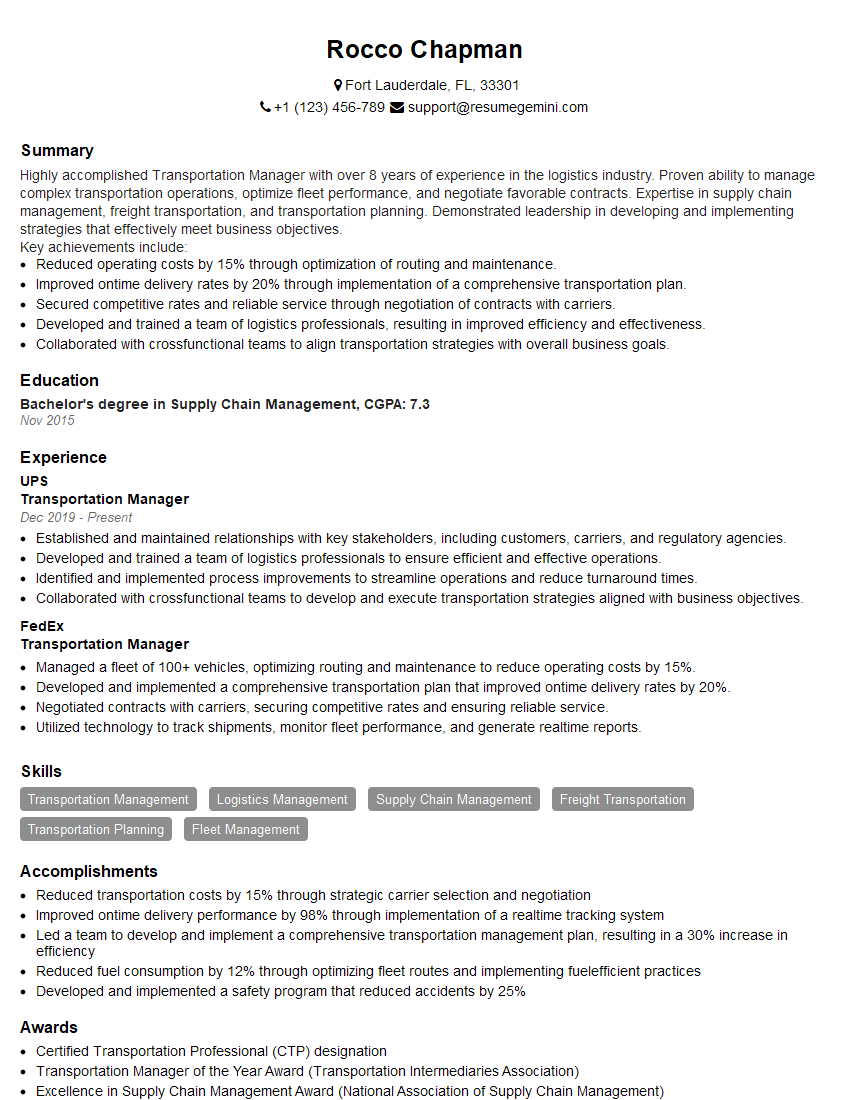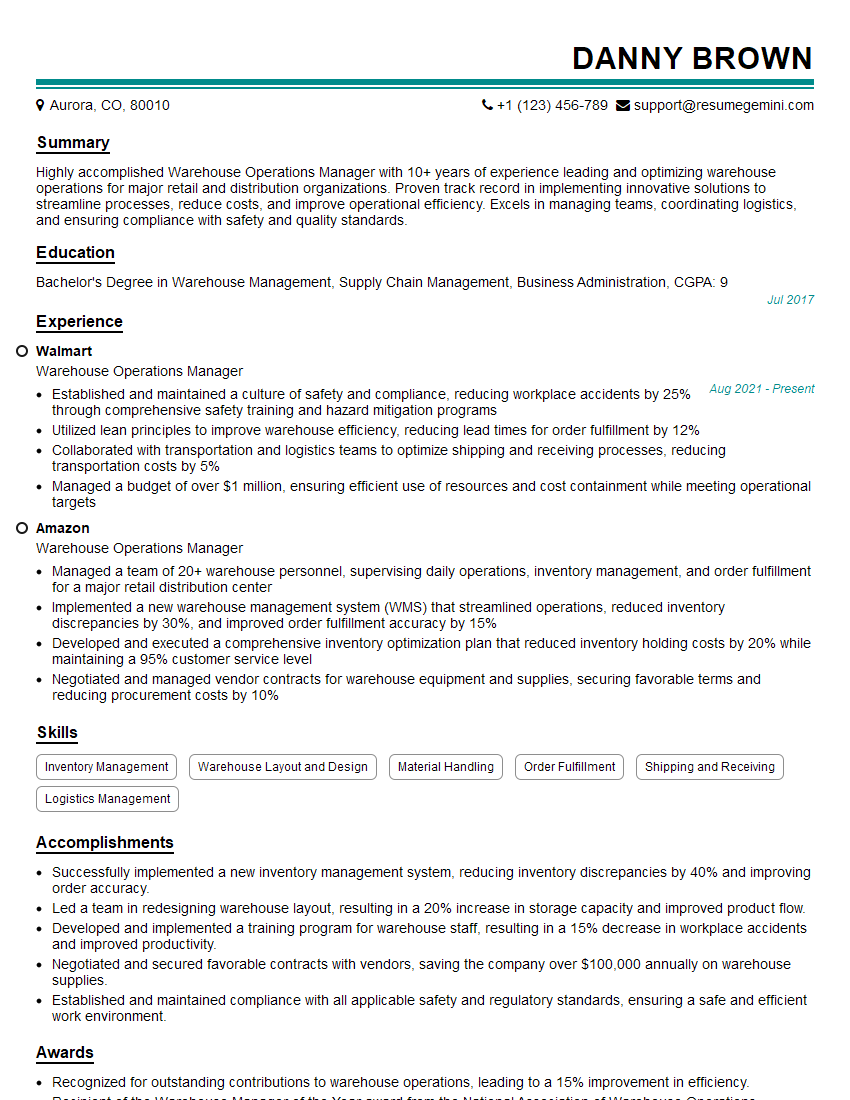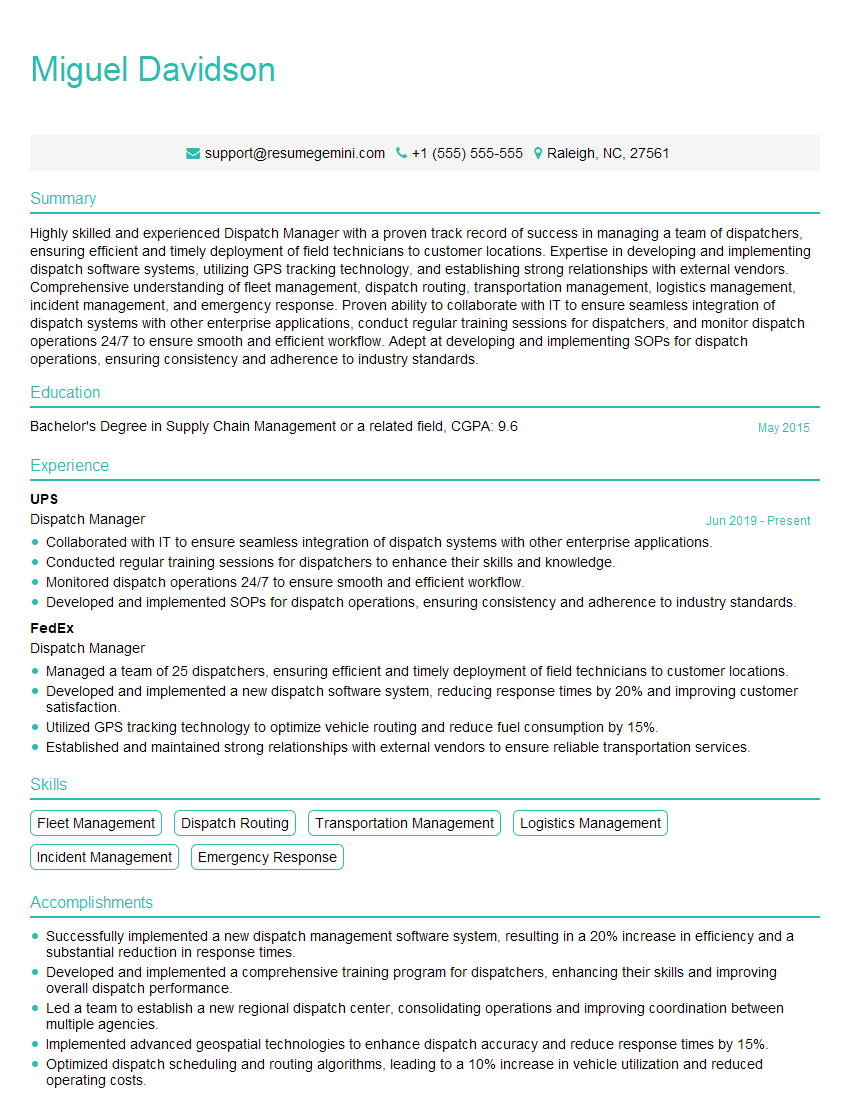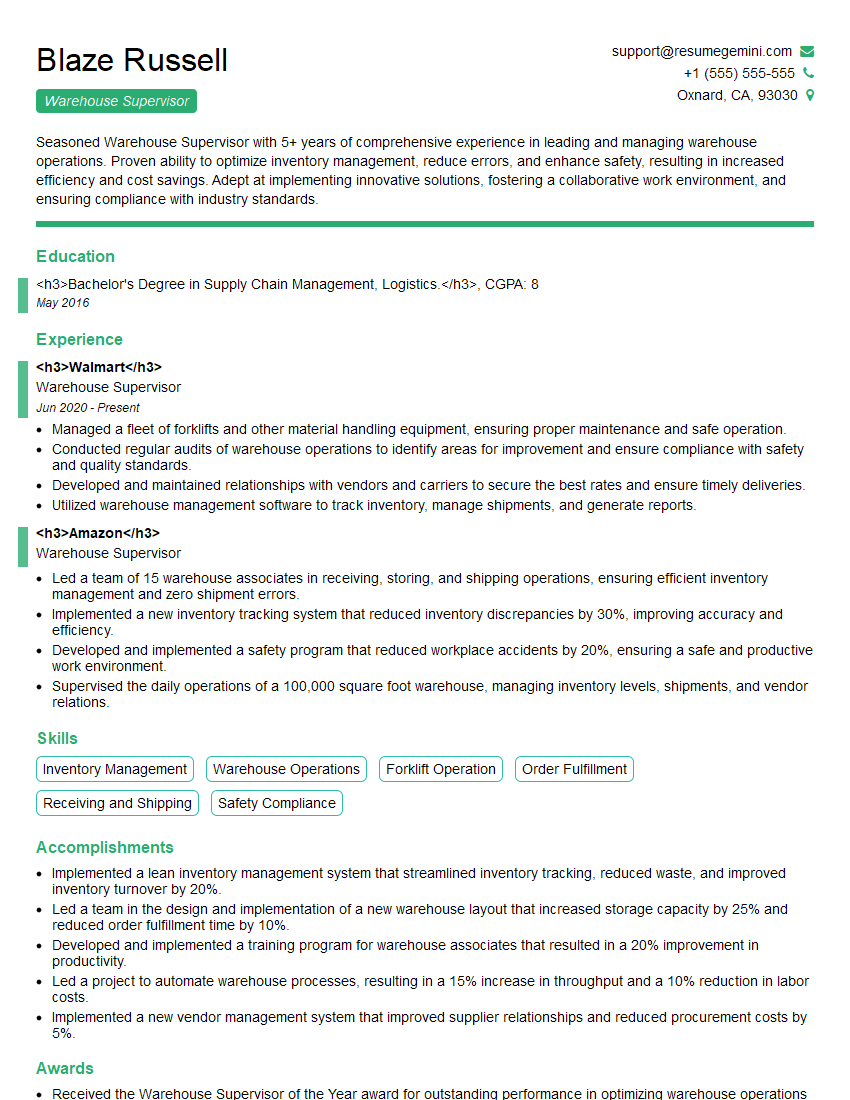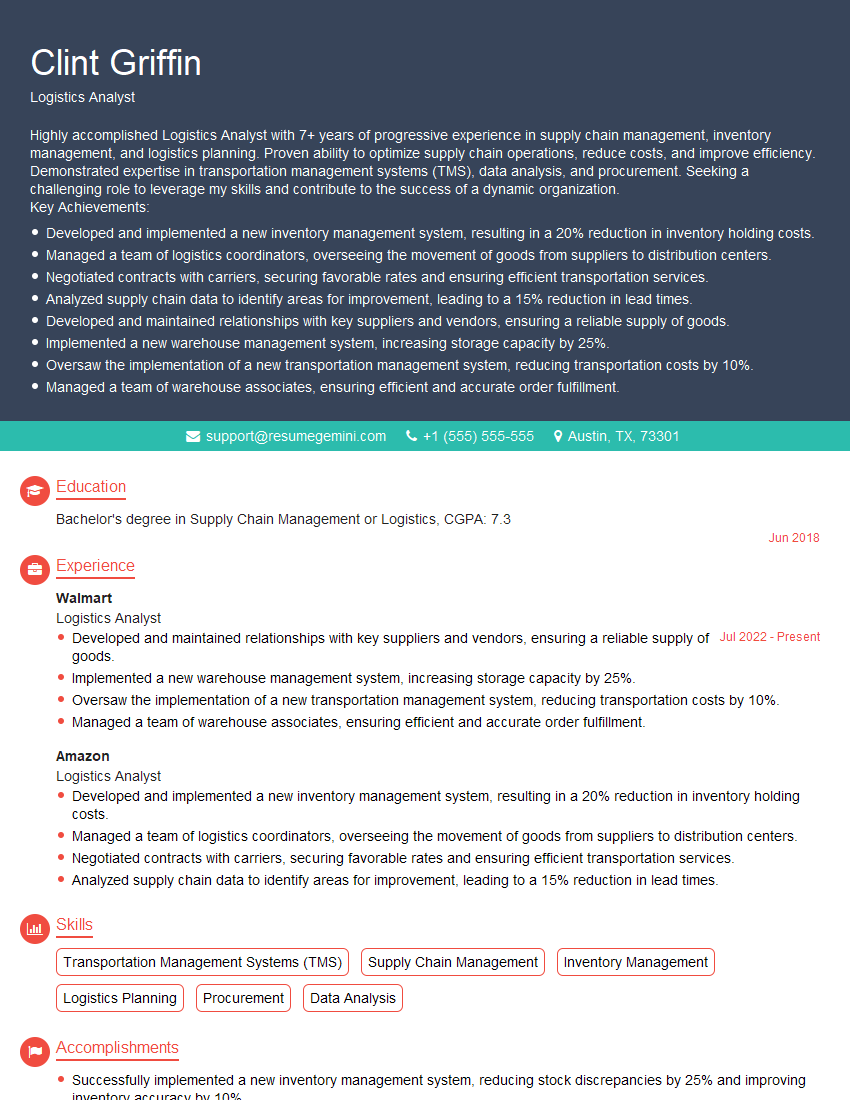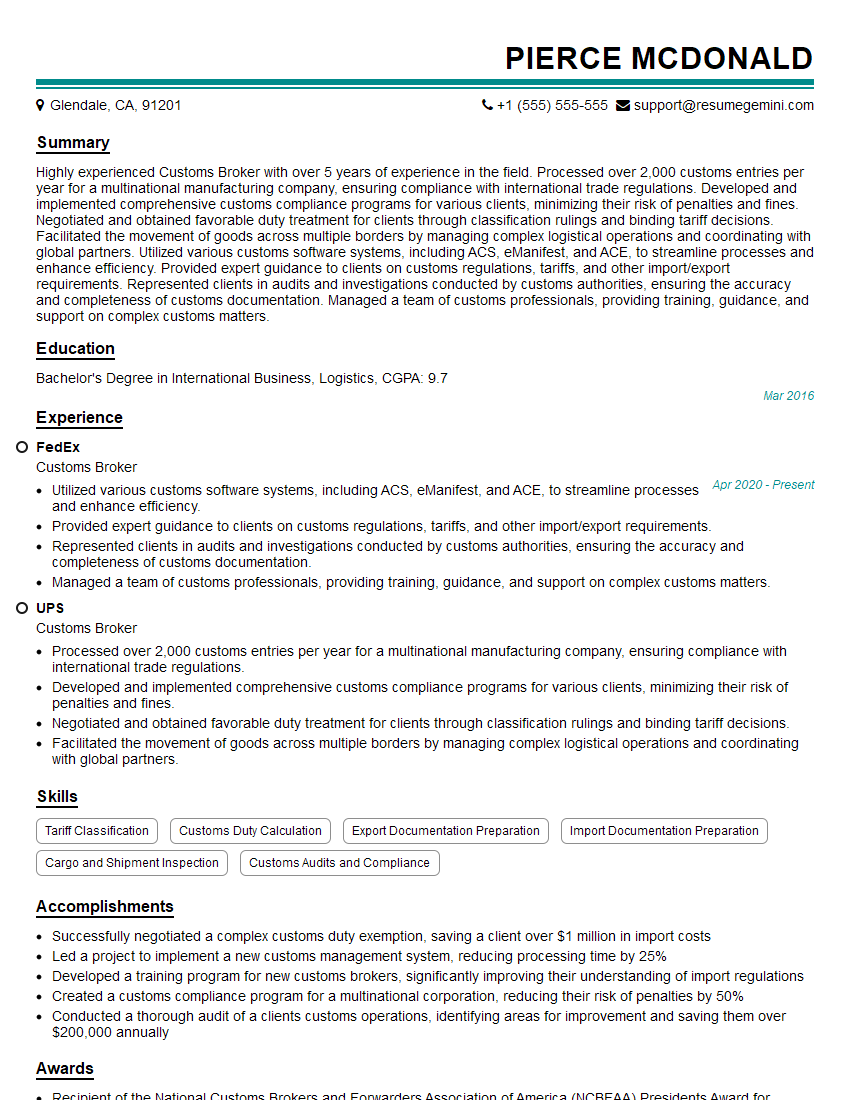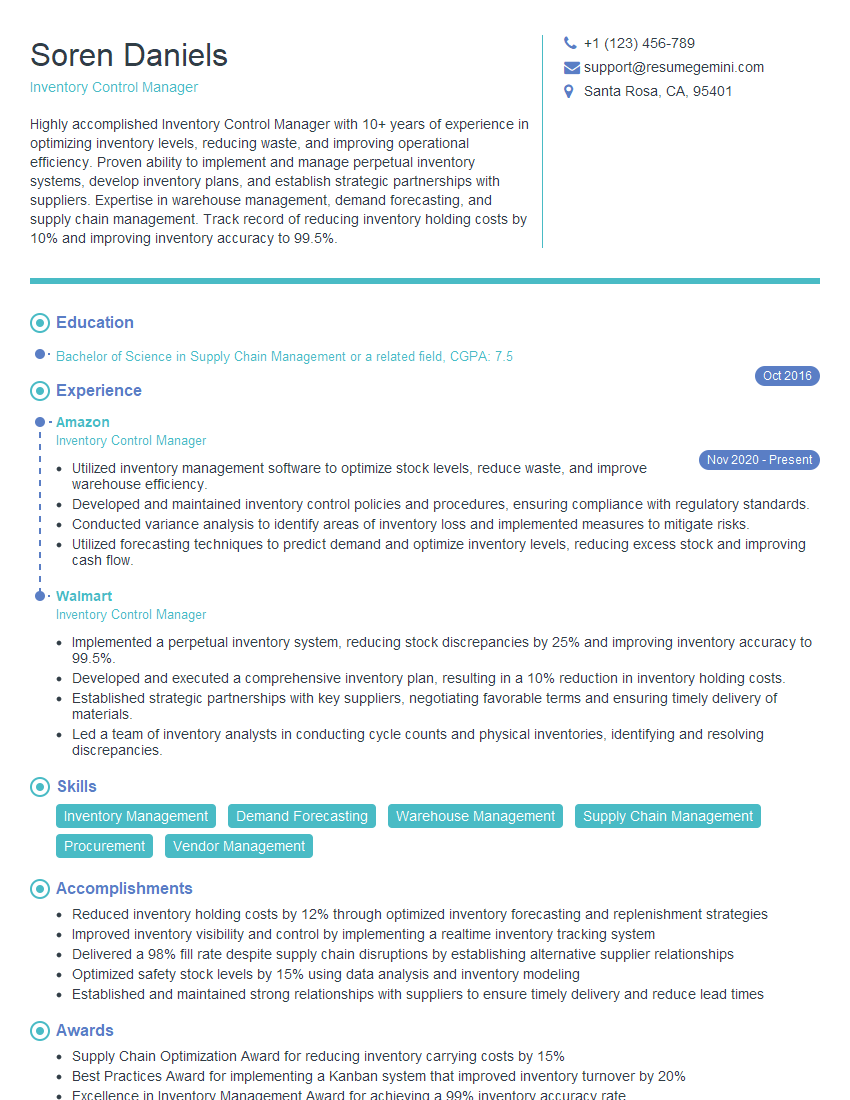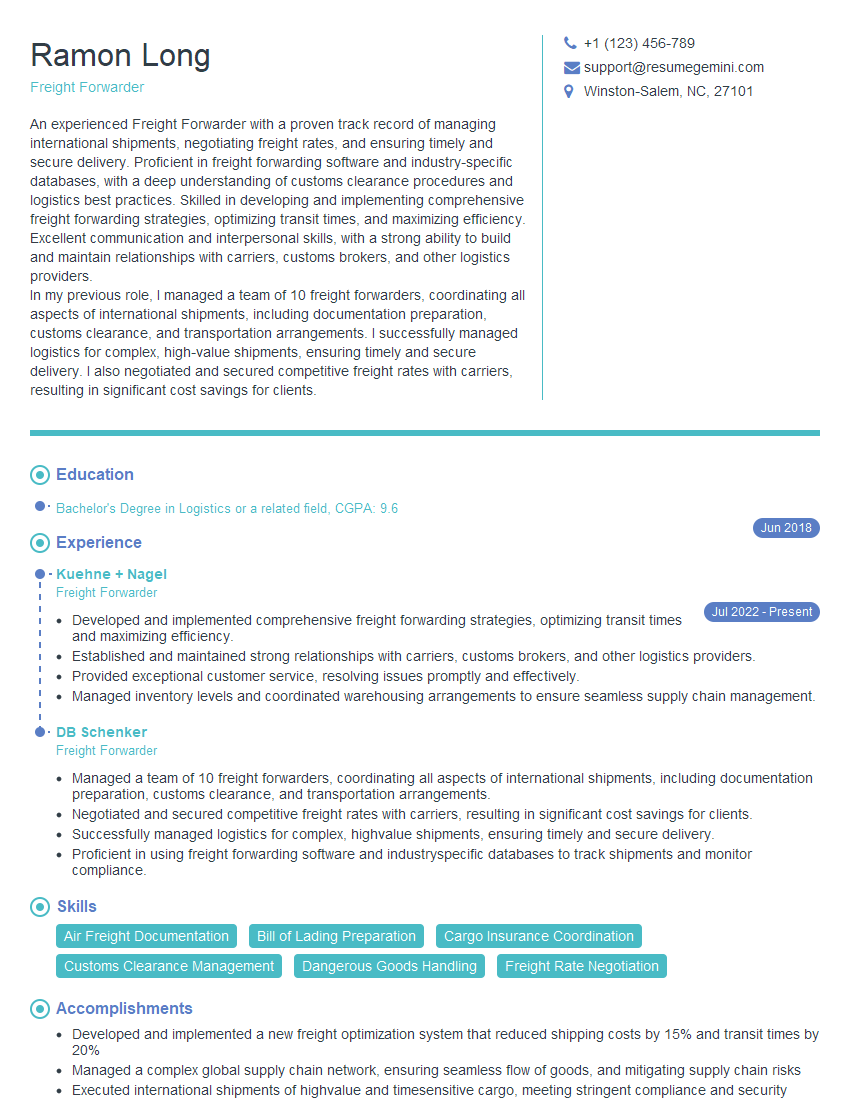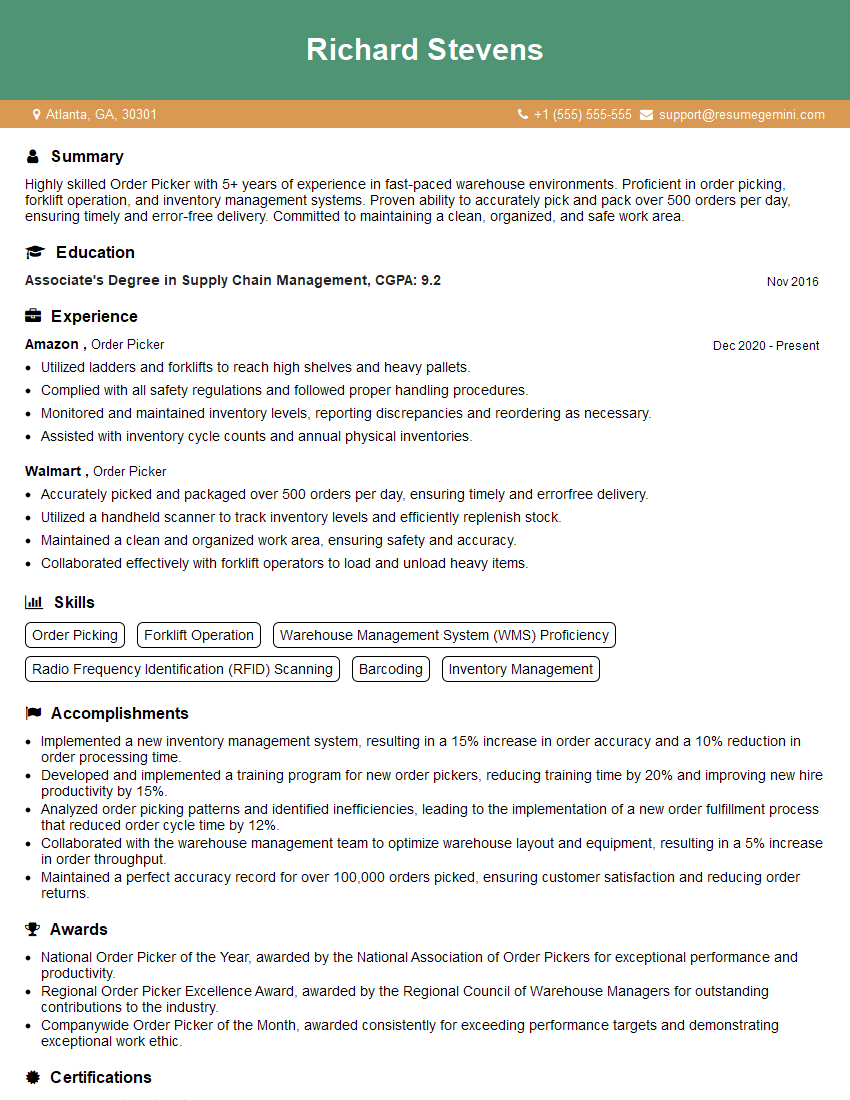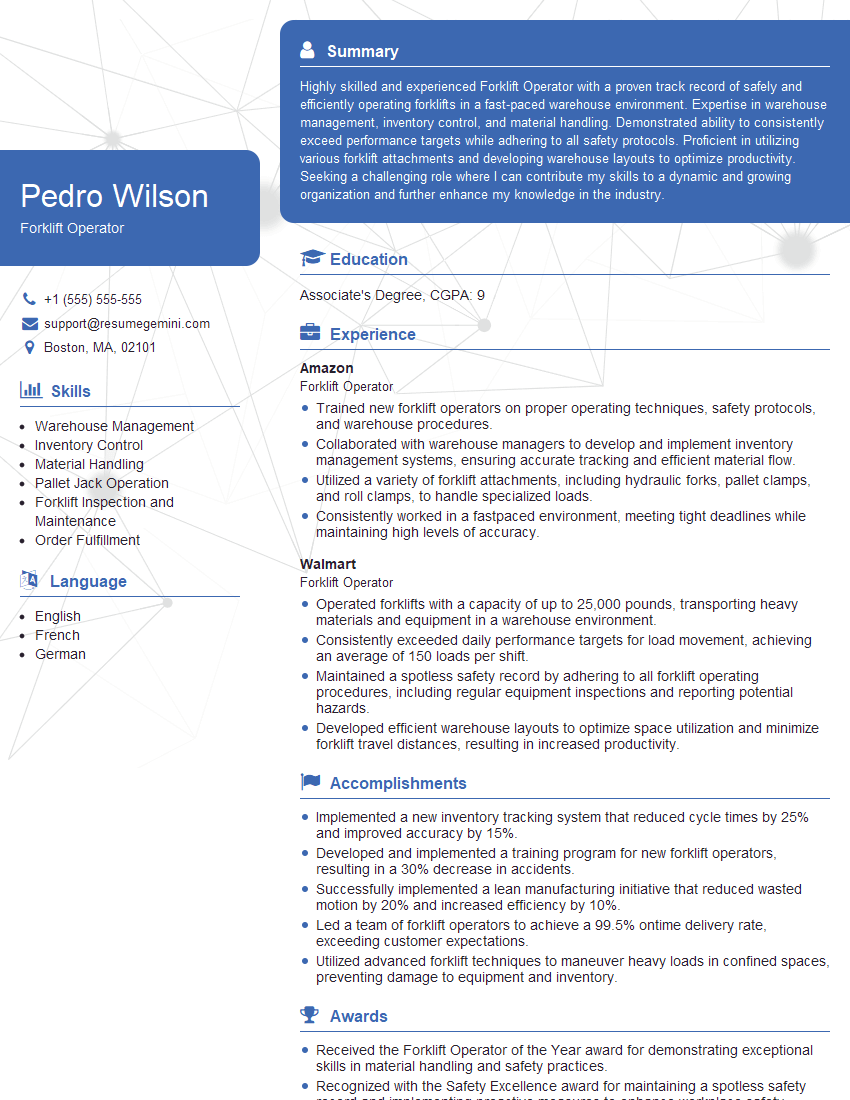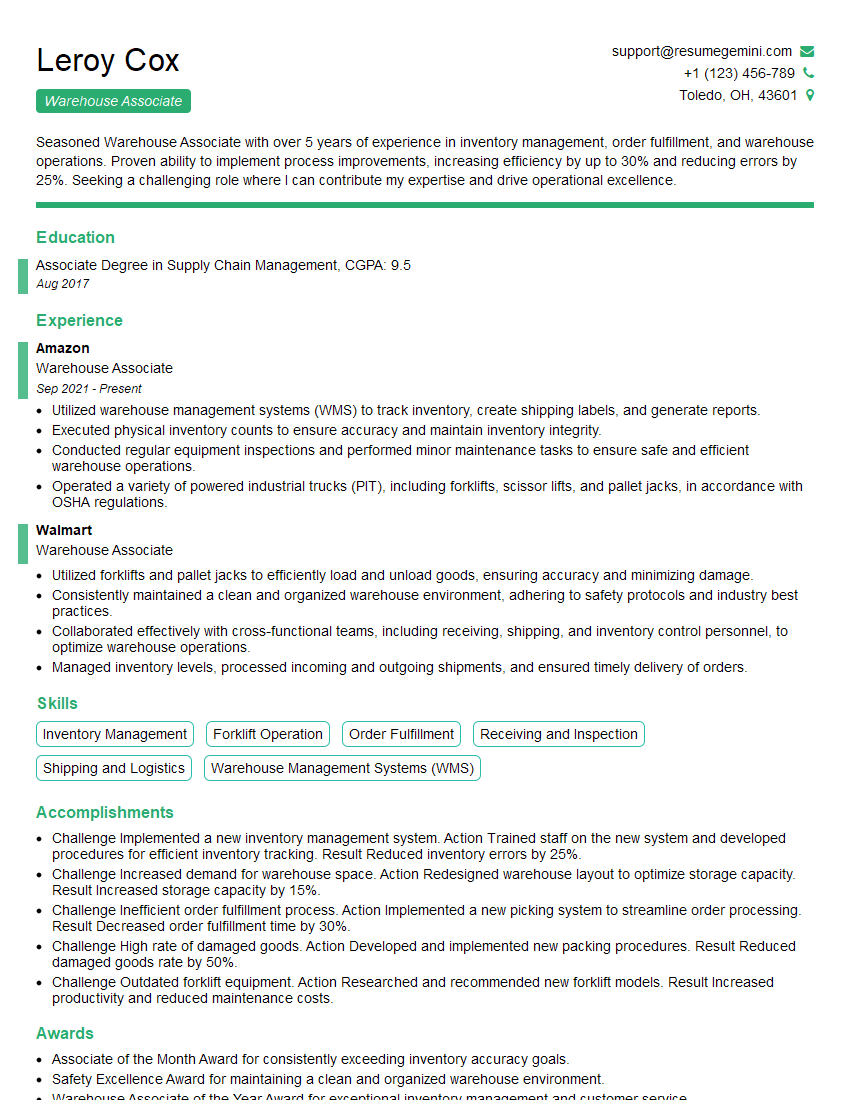Every successful interview starts with knowing what to expect. In this blog, we’ll take you through the top Materials Handling and Logistics interview questions, breaking them down with expert tips to help you deliver impactful answers. Step into your next interview fully prepared and ready to succeed.
Questions Asked in Materials Handling and Logistics Interview
Q 1. Explain the difference between FIFO and LIFO inventory management.
FIFO and LIFO are two fundamental inventory accounting methods that dictate the order in which inventory items are expensed. FIFO stands for “First-In, First-Out,” meaning the oldest items are sold first. LIFO stands for “Last-In, First-Out,” where the newest items are sold first.
Imagine a bakery. Using FIFO, the first batch of croissants baked would be the first sold. Any spoilage would affect the oldest items. Using LIFO, the last batch of croissants baked would be sold first. This is less intuitive for perishable goods.
The choice between FIFO and LIFO impacts financial statements. FIFO generally results in higher reported profits during periods of inflation because the cost of goods sold is lower (older, cheaper inventory). LIFO, conversely, leads to lower reported profits but a more accurate reflection of current costs. The tax implications also differ significantly. LIFO often leads to lower tax liabilities during inflation, as higher costs of goods sold reduce taxable income.
Choosing the right method depends on various factors, including the nature of the inventory (perishable vs. non-perishable), tax implications, and management’s reporting preferences. Understanding both is crucial for efficient inventory management and accurate financial reporting.
Q 2. Describe your experience with Warehouse Management Systems (WMS).
My experience with Warehouse Management Systems (WMS) spans over eight years, encompassing implementation, customization, and ongoing support across various industries. I’ve worked with both cloud-based and on-premise WMS solutions, including popular platforms like Manhattan Associates, Blue Yonder, and NetSuite.
In my previous role at Acme Distribution, I led the implementation of a new WMS, resulting in a 20% reduction in order fulfillment time and a 15% decrease in picking errors. This involved detailed process mapping, user training, and ongoing system optimization. I’m proficient in configuring various WMS modules, including inventory management, receiving, putaway, picking, packing, shipping, and reporting. My expertise extends to integrating WMS with other enterprise systems like ERP and TMS to ensure seamless data flow across the supply chain.
I’m adept at troubleshooting system issues, optimizing workflows, and tailoring the system to meet specific business requirements. For example, I customized a WMS to incorporate a slotting optimization algorithm, reducing travel time for pickers by 12%.
Q 3. What are the key performance indicators (KPIs) you would track in a warehouse?
Key Performance Indicators (KPIs) are essential for monitoring warehouse performance and identifying areas for improvement. The specific KPIs I’d track would depend on the warehouse’s objectives, but some critical metrics include:
- Order fulfillment rate: The percentage of orders fulfilled accurately and on time.
- Inventory accuracy: The level of agreement between the physical inventory and the system’s records.
- Order cycle time: The time it takes to process an order from receipt to shipment.
- Warehouse operating cost per unit: The cost of operating the warehouse per unit of goods handled.
- Storage utilization: The percentage of available storage space being used efficiently.
- Picking accuracy: The percentage of orders picked correctly.
- Safety incidents: The number of safety incidents per employee or per hour worked.
- On-time shipping rate: The percentage of shipments leaving on schedule.
Regular monitoring and analysis of these KPIs, coupled with root-cause analysis for deviations, are critical for continuous improvement and operational excellence.
Q 4. How would you improve efficiency in a warehouse experiencing high order volume?
Improving efficiency in a high-volume warehouse requires a multi-faceted approach focusing on process optimization, technology utilization, and workforce management.
- Optimize Warehouse Layout: Implementing a dynamic slotting system based on product popularity and order frequency can significantly reduce travel times for pickers. Cross-docking strategies should be considered to minimize storage time.
- Improve Picking Processes: Employing methods like batch picking, zone picking, or wave picking can streamline the picking process. Investing in automation like automated guided vehicles (AGVs) or conveyor systems can significantly reduce manual effort.
- Invest in Technology: WMS integration, RFID technology, and barcode scanning can significantly increase accuracy and efficiency, reducing errors and improving order tracking.
- Improve Labor Management: Effective scheduling, cross-training employees, and providing adequate breaks can increase productivity and morale. Performance monitoring and feedback are critical for continuous improvement.
- Outsourcing: Consider outsourcing certain functions, such as transportation or specialized handling, if it is cost-effective.
A phased approach with clear objectives and measurable results is crucial for success. Continuous monitoring of KPIs and regular reviews are essential for ongoing optimization.
Q 5. What are your strategies for managing warehouse safety?
Warehouse safety is paramount. My strategy centers on a proactive, multi-layered approach:
- Regular Safety Audits and Inspections: Conducting routine inspections to identify and mitigate potential hazards. Following OSHA guidelines and industry best practices is crucial.
- Employee Training and Education: Providing comprehensive safety training to all warehouse staff on topics such as equipment operation, material handling techniques, and emergency procedures.
- Proper Equipment Maintenance: Regular maintenance of all equipment (forklifts, conveyors, etc.) to ensure optimal functionality and prevent accidents.
- Ergonomic Design: Designing the workspace to minimize ergonomic risks, including proper lighting, clear pathways, and adjustable work surfaces.
- Personal Protective Equipment (PPE): Providing and enforcing the use of appropriate PPE, such as safety shoes, gloves, and high-visibility vests.
- Incident Reporting and Investigation: Establishing a clear reporting procedure for all incidents and conducting thorough investigations to identify root causes and implement corrective actions.
- Emergency Preparedness: Developing and practicing emergency response plans for various scenarios, including fires, spills, and medical emergencies.
Safety is not merely a policy; it’s a culture that needs to be fostered and constantly reinforced through communication, training, and visible leadership commitment.
Q 6. Explain your understanding of different transportation modes (e.g., rail, road, sea, air).
Different transportation modes each offer unique advantages and disadvantages, impacting cost, speed, and capacity.
- Road Transport: Highly flexible and accessible, ideal for short-to-medium distances and smaller shipments. However, it can be susceptible to traffic congestion and weather delays.
- Rail Transport: Cost-effective for long distances and large volumes of goods. Less flexible than road transport and requires access to rail infrastructure.
- Sea Transport: Extremely cost-effective for transporting large quantities of goods over long distances. However, it’s the slowest mode and susceptible to port congestion and weather conditions.
- Air Transport: The fastest mode, ideal for high-value, time-sensitive goods. Significantly more expensive than other modes and limited in terms of cargo capacity.
The choice of transportation mode depends on factors like the distance, urgency, volume, value, and fragility of the goods. Often, a multimodal approach—combining different modes—provides the most efficient and cost-effective solution.
Q 7. How do you optimize routing and scheduling for efficient delivery?
Optimizing routing and scheduling for efficient delivery involves utilizing technology and strategic planning.
- Route Optimization Software: Employing software that considers factors like distance, traffic patterns, delivery windows, and vehicle capacity to generate the most efficient delivery routes. This minimizes travel time and fuel consumption.
- Load Planning and Consolidation: Consolidating shipments to maximize vehicle utilization and reduce the number of deliveries required. Careful load planning prevents damage and ensures efficient unloading.
- Real-Time Tracking and Monitoring: Using GPS tracking to monitor vehicle location, identify potential delays, and make adjustments to the schedule as needed.
- Delivery Window Management: Coordinating deliveries within specific time windows to reduce waiting times and improve customer satisfaction.
- Communication and Collaboration: Maintaining clear communication with drivers and customers to ensure timely and accurate deliveries.
By integrating these strategies, businesses can improve delivery efficiency, reduce costs, and enhance customer satisfaction. Regular review and adjustment of routing and scheduling plans based on performance data is key to continuous improvement.
Q 8. Describe your experience with inventory control and cycle counting.
Inventory control is the systematic process of managing and tracking the flow of goods within a warehouse or supply chain. Cycle counting is a key component of this, involving the regular physical verification of inventory levels, comparing them against recorded quantities, and investigating discrepancies. In my previous role at Acme Distribution, I implemented a robust inventory control system utilizing a barcode scanning system and a dedicated Warehouse Management System (WMS). This significantly improved accuracy compared to the previous manual system. We employed a cycle counting strategy that focused on high-value or fast-moving items more frequently, while slower-moving items were checked less often. This optimized our resource allocation and minimized disruption to daily operations. For example, our A-class items (highest value/demand) were counted weekly, B-class items bi-weekly, and C-class items monthly. This tiered approach ensured that we maintained a high degree of accuracy across the entire inventory, minimizing stockouts and overstocking.
Q 9. What is your approach to managing inventory discrepancies?
My approach to managing inventory discrepancies involves a systematic investigation to identify the root cause. This usually starts with a thorough review of the cycle counting data to pinpoint the location and extent of the discrepancy. Next, I’d examine potential causes, such as data entry errors, damage, theft, or misplacement. For example, if a significant discrepancy exists for a specific product, I’d investigate potential issues like incorrect product labeling, damaged packaging, or even supplier-related problems. I would then implement corrective actions tailored to the root cause; this might involve retraining staff on proper data entry procedures, improving warehouse organization, enhancing security measures, or refining receiving processes to prevent errors in the future. Documentation of the entire process, including the discrepancy, investigation, and corrective actions, is critical for preventing future issues. This ensures continuous improvement in inventory accuracy.
Q 10. How familiar are you with Lean manufacturing principles and their application in logistics?
I’m very familiar with Lean manufacturing principles, particularly their application in optimizing logistics and supply chain operations. Lean principles focus on eliminating waste (Muda) in all forms, from excess inventory (overproduction) to unnecessary movement and waiting time. In a previous project, I implemented Kanban systems to manage inventory flow between different stages of our production process. This significantly reduced lead times and inventory holding costs. We also employed 5S methodology to improve workplace organization, leading to increased efficiency and reduced search times for materials. Value stream mapping allowed us to visualize the entire material flow and identify bottlenecks, allowing for targeted improvements. For example, we identified a bottleneck in the packaging stage that was causing delays, and by implementing a more efficient packaging line, we were able to significantly increase throughput. Lean methodologies are crucial for creating efficient, cost-effective, and responsive logistics processes.
Q 11. Explain your experience with various types of material handling equipment.
My experience encompasses a wide range of material handling equipment, including forklifts (both sit-down and stand-up), pallet jacks, conveyors (roller, belt, and chain), automated guided vehicles (AGVs), and various types of cranes. I’m proficient in operating these machines safely and efficiently, and I understand their maintenance requirements. In my previous role, I was responsible for overseeing the maintenance and scheduling of equipment, ensuring optimal uptime and minimal downtime. I’m also familiar with the selection criteria for different equipment based on factors like payload capacity, operating environment, and cost-effectiveness. For instance, when we needed to improve the efficiency of our warehouse picking process, we evaluated different conveyor systems before selecting a combination of roller and belt conveyors that best suited our needs.
Q 12. How would you handle a situation with damaged goods during shipping?
Handling damaged goods requires a systematic approach. First, I’d document the damage thoroughly, including taking photographs and noting the extent of the damage and the affected items. This documentation is critical for insurance claims and for identifying potential issues with the packaging or handling process. Second, I’d determine the cause of damage – was it due to improper handling during shipping, faulty packaging, or inherent product defects? This investigation helps prevent similar incidents in the future. Next, I’d assess the salvageability of the goods. If repairable, we’d initiate repairs; if not, I’d initiate a return process with the carrier and/or supplier, depending on the insurance coverage and responsibility. For example, if damage was caused by the carrier, we’d file a claim with their insurance. If the damage was due to a packaging issue, we’d review our packaging protocols and make changes as needed. Proper documentation and a clear chain of responsibility are crucial in this process.
Q 13. Describe your experience with international shipping regulations and documentation.
I possess extensive experience with international shipping regulations and documentation. I’m familiar with various Incoterms (International Commercial Terms), such as DDP, CIF, and FOB, and understand their implications for responsibility and costs. I’m also well-versed in the required documentation for customs clearance, including commercial invoices, packing lists, certificates of origin, and other specific documents depending on the product and destination country. I have a strong understanding of HS codes (Harmonized System codes) and their importance in classifying goods for customs purposes. In a previous project, we successfully navigated complex import/export regulations for shipping sensitive electronic components to various international markets. We ensured compliance with all relevant regulations and minimized delays by properly preparing all the necessary documentation in advance. Accurate and timely documentation is paramount for smooth international shipping.
Q 14. How do you prioritize orders for fulfillment in a high-pressure environment?
Prioritizing orders in a high-pressure environment requires a structured approach. I would typically use a system that takes into account several factors, such as order due dates, customer importance (e.g., VIP customers), order size, and product availability. I might employ a prioritization matrix that assigns weights to these factors, allowing for a more objective ranking of orders. Real-time order tracking and communication with the fulfillment team are essential for maintaining transparency and managing expectations. In situations with conflicting priorities, open communication with the customer and transparently explaining potential delays is crucial. For example, I’d use a software system that automatically routes orders based on their priority level, allowing for efficient allocation of resources and timely fulfillment. In such a scenario, flexibility and a problem-solving mindset are essential for navigating unexpected challenges.
Q 15. How do you manage and resolve conflicts between different departments within logistics?
Resolving inter-departmental conflicts in logistics requires a collaborative and communicative approach. It’s crucial to understand that each department – warehousing, transportation, procurement, etc. – has its own priorities and performance metrics. Conflicts often arise from misaligned goals or a lack of clear communication.
My approach involves:
- Facilitating Open Communication: I establish regular cross-functional meetings where representatives from each department can openly discuss challenges, concerns, and potential solutions. This creates a safe space for airing grievances and finding common ground.
- Defining Shared Goals: I work to define overarching logistics goals that benefit all departments. For instance, improving on-time delivery rates benefits both transportation and warehousing. Alignment around these shared goals reduces the likelihood of conflicting priorities.
- Utilizing Data-Driven Decision Making: I advocate for using data to resolve disputes. If warehousing claims insufficient resources, for instance, we analyze throughput data to objectively assess capacity needs and justify resource allocation requests.
- Mediation and Conflict Resolution: In cases of intractable disputes, I act as a mediator, helping departments find mutually acceptable solutions through compromise and negotiation. This might involve prioritizing tasks, adjusting deadlines, or reallocating resources.
- Establishing Clear Communication Protocols: Implementing clear communication protocols, such as daily briefings or shared dashboards, helps prevent misunderstandings and ensures everyone is informed of developments.
For example, in a previous role, a conflict arose between warehousing and transportation due to inconsistent order fulfillment times. By analyzing data on order processing, warehouse capacity, and transportation schedules, we identified bottlenecks in the warehousing process. Implementing a new warehouse management system (WMS) and optimizing picking routes ultimately resolved the issue and improved overall efficiency.
Career Expert Tips:
- Ace those interviews! Prepare effectively by reviewing the Top 50 Most Common Interview Questions on ResumeGemini.
- Navigate your job search with confidence! Explore a wide range of Career Tips on ResumeGemini. Learn about common challenges and recommendations to overcome them.
- Craft the perfect resume! Master the Art of Resume Writing with ResumeGemini’s guide. Showcase your unique qualifications and achievements effectively.
- Don’t miss out on holiday savings! Build your dream resume with ResumeGemini’s ATS optimized templates.
Q 16. What software or tools have you used for tracking and managing shipments?
Throughout my career, I’ve used a variety of software and tools for shipment tracking and management. The specific tools depend on the scale and complexity of the operation, but some examples include:
- Transportation Management Systems (TMS): These systems, such as Oracle Transportation Management or SAP TM, provide end-to-end visibility across the transportation lifecycle, from order placement to delivery confirmation. They optimize routes, manage carriers, and track shipments in real-time.
- Warehouse Management Systems (WMS): Systems like Blue Yonder or Manhattan Associates manage inventory, track goods within the warehouse, optimize storage, and direct picking and packing processes. Integration with TMS is crucial for seamless flow.
- Global Positioning System (GPS) Tracking: Real-time tracking of vehicles and shipments using GPS devices provides precise location information, enhancing security and improving delivery predictability.
- Enterprise Resource Planning (ERP) Systems: Systems like SAP or Oracle integrate logistics functions with other business processes, providing a holistic view of the supply chain. They facilitate planning, procurement, and inventory management.
In one instance, implementing a new TMS resulted in a 15% reduction in transportation costs and a 10% improvement in on-time delivery rates by optimizing routes and carrier selection based on real-time data and predictive analytics.
Q 17. What is your experience with implementing new logistics technologies?
Implementing new logistics technologies requires a structured and phased approach. It’s not just about purchasing the latest software; it’s about integrating it effectively into existing workflows and training personnel.
My experience includes:
- Needs Assessment: Begin by thoroughly assessing the current logistics processes to identify pain points and areas where technology can improve efficiency and reduce costs.
- Technology Selection: Carefully evaluate different technologies based on functionality, scalability, integration capabilities, and cost. Consider vendor support and future upgrade paths.
- Pilot Program: Implementing a pilot program in a limited area allows for testing and refinement before full-scale deployment, minimizing disruption and risk.
- Change Management: Effective change management is crucial. This involves educating and training employees on the new technology, addressing concerns, and securing their buy-in. This also includes a robust communication strategy that keeps all stakeholders informed about the progress and benefits of the implementation.
- Data Migration: Migrating data from legacy systems to the new technology requires careful planning and execution to ensure data accuracy and integrity.
- Integration: Seamless integration with existing systems (WMS, TMS, ERP) is critical for optimal performance. This often requires custom development or configuration.
- Post-Implementation Review: A thorough review after implementation helps identify areas for improvement and ensures the technology is delivering expected benefits.
For example, in a previous role, we successfully implemented a new WMS, resulting in a 20% reduction in warehouse operating costs and a 10% increase in order fulfillment accuracy. Key to this success was a comprehensive training program and effective communication throughout the implementation process.
Q 18. How do you forecast demand and ensure sufficient inventory levels?
Accurate demand forecasting is vital for maintaining optimal inventory levels. Overstocking ties up capital and risks obsolescence, while understocking leads to lost sales and dissatisfied customers. My approach combines qualitative and quantitative methods:
- Historical Data Analysis: Analyzing past sales data using time series analysis, moving averages, or exponential smoothing techniques reveals trends and seasonality patterns. Software like Excel or specialized forecasting tools are used for this.
- Market Research: Gathering information on market trends, economic indicators, and competitor activity provides insights into future demand. This includes analyzing industry reports and conducting customer surveys.
- Sales and Marketing Input: Collaborating closely with sales and marketing teams gives valuable insights into planned promotions, new product launches, and anticipated changes in customer demand.
- External Factors: Considering external factors like weather patterns (for seasonal goods), economic conditions, and geopolitical events that might affect demand is critical.
- Safety Stock: Maintaining a safety stock buffer accounts for unexpected fluctuations in demand or supply chain disruptions. The level of safety stock is determined based on historical data and desired service levels.
- Inventory Turnover: Regularly monitoring inventory turnover helps identify slow-moving items and adjust inventory levels accordingly.
For instance, using a combination of historical sales data and anticipated marketing campaigns, I accurately predicted a significant increase in demand for a particular product during the holiday season, enabling us to proactively increase inventory levels and avoid stockouts.
Q 19. Explain your approach to managing supplier relationships.
Managing supplier relationships is crucial for a reliable and efficient supply chain. It goes beyond simple procurement; it’s about building long-term partnerships.
My approach focuses on:
- Supplier Selection: Carefully evaluating potential suppliers based on factors like quality, reliability, capacity, cost, and ethical practices.
- Collaboration and Communication: Establishing clear communication channels and regular meetings with key suppliers to foster transparency and collaboration. This includes sharing forecasts and production plans.
- Performance Monitoring: Tracking supplier performance based on metrics such as on-time delivery, quality, and cost. Regular performance reviews are conducted to identify areas for improvement.
- Relationship Building: Cultivating strong relationships with suppliers through trust and mutual respect. This might involve visiting their facilities and engaging in collaborative problem-solving.
- Risk Management: Identifying and mitigating potential risks associated with supplier relationships, such as supply chain disruptions or quality issues. This often involves diversification of suppliers and having contingency plans in place.
- Continuous Improvement: Working with suppliers to identify opportunities for continuous improvement in quality, efficiency, and cost.
In one case, by fostering a strong relationship with a key supplier, we were able to negotiate favorable pricing terms and secure priority access to their products during a period of high demand, mitigating potential supply chain risks.
Q 20. How do you measure the effectiveness of logistics processes?
Measuring the effectiveness of logistics processes involves tracking key performance indicators (KPIs) across various aspects of the supply chain. These KPIs provide insights into performance, identify areas for improvement, and support data-driven decision-making.
Some important KPIs include:
- On-Time Delivery Rate: Percentage of orders delivered on or before the scheduled delivery date.
- Order Fulfillment Cycle Time: Time taken from order placement to delivery.
- Inventory Turnover Rate: How many times inventory is sold and replenished in a given period.
- Warehouse Space Utilization: Percentage of available warehouse space being used effectively.
- Transportation Costs per Unit: Cost of transportation per unit of goods shipped.
- Customer Order Accuracy: Percentage of orders fulfilled without errors.
- Perfect Order Rate: Percentage of orders delivered on time, in full, and without errors.
- Damage Rate: Percentage of goods damaged during handling and transportation.
Regular monitoring and analysis of these KPIs help identify areas needing improvement. For instance, a consistently low on-time delivery rate might indicate issues with transportation planning or warehouse efficiency. By tracking these metrics, we can develop targeted improvement initiatives, and measure their effectiveness.
Q 21. What is your understanding of different warehousing layouts and their benefits?
Warehousing layouts significantly impact efficiency and cost-effectiveness. The optimal layout depends on factors such as product type, order volume, and storage needs. Here are some common layouts:
- U-Shaped Layout: Efficient for smaller warehouses where minimizing travel distance is crucial. Suitable for low-volume operations.
- L-Shaped Layout: A compromise between U-shaped and I-shaped; offers some flexibility and efficiency.
- I-Shaped Layout: Straightforward and simple, ideal for low-volume, high-velocity goods with minimal product variety. Often employed for smaller operations with limited space.
- Random Storage: Suitable for high-volume operations with many different products. A WMS is essential for managing and tracking inventory. Offers flexibility and can optimize space utilization.
- Dedicated Storage: Each product or product family has a designated area. Simple to manage, but can be inefficient if space is not utilized fully.
- Block Stacking: Storing goods in large blocks, usually using forklifts or other heavy equipment. Suitable for large, bulky items. Space efficiency is a key advantage.
The choice of layout significantly impacts efficiency. For instance, a poorly designed layout can result in unnecessary travel time for warehouse personnel, leading to increased labor costs and reduced throughput. A well-designed layout, on the other hand, can optimize space utilization, reduce handling time, and improve overall efficiency. The selection process should involve careful consideration of throughput requirements, product characteristics, and technology available.
Q 22. Describe your experience with optimizing warehouse space utilization.
Optimizing warehouse space utilization is crucial for efficiency and profitability. It involves strategically arranging storage locations, optimizing picking routes, and maximizing vertical space to minimize wasted area and improve throughput. This requires a deep understanding of inventory characteristics, order patterns, and material handling equipment capabilities.
In my previous role at Acme Distribution, we implemented a zone-based picking system. Previously, we used a random picking method, leading to significant travel time for pickers. By analyzing order data, we divided the warehouse into zones based on product frequency and assigned pickers to specific zones. This reduced travel time by 35%, increasing picker productivity and order fulfillment speed. We also implemented vertical storage using high-bay racking, effectively doubling our storage capacity without increasing floor space.
Further optimization involved implementing slotting optimization software. This software analyzes product demand, size, and weight to assign the most efficient storage location for each SKU. This considers factors like fast-moving items placed closer to shipping docks and slow-moving items in higher or less accessible locations. The result was a 20% reduction in order picking time and a significant improvement in overall warehouse efficiency.
Q 23. How do you ensure timely and accurate order fulfillment?
Timely and accurate order fulfillment hinges on a well-integrated system encompassing order management, inventory control, picking, packing, and shipping. Effective communication across departments is vital, coupled with robust technology and skilled personnel. Accuracy is maintained through barcode scanning, weight verification, and quality checks at each stage.
Think of it like a well-oiled machine – each part needs to function perfectly for the whole system to deliver on time. For example, at Beta Manufacturing, we integrated our warehouse management system (WMS) with our order management system (OMS) and our transportation management system (TMS). This integration allowed for real-time visibility into inventory levels, order status, and shipment tracking. This eliminated manual data entry errors and improved communication between departments, resulting in a 15% reduction in order fulfillment errors and a 10% increase in on-time delivery rates.
We also implemented a quality control checkpoint before shipping, where every order is verified against the order details. This final check helps identify and correct errors before they reach the customer, ensuring a high level of accuracy and customer satisfaction.
Q 24. What is your experience with different types of packaging and its impact on logistics?
Packaging choice significantly impacts logistics costs and product integrity. Factors to consider include material type (corrugated cardboard, plastic, etc.), size and weight, cushioning requirements, and environmental impact. Different product characteristics demand different packaging solutions. Fragile items require robust packaging to prevent damage during transit, while lightweight items may use lighter, more economical packaging. The choice also affects storage space and shipping costs.
For example, during my time at Gamma Corp, we switched from using bulky, custom-made wooden crates for heavy machinery to reusable plastic crates. This reduced shipping costs by 40% due to lower weight and improved stacking efficiency on pallets. It also lowered storage space requirements and reduced environmental impact due to reduced material waste. For smaller, less fragile products, we transitioned to eco-friendly, biodegradable packaging. This reflected our commitment to sustainable practices and aligned with customer preference for environmentally conscious products.
A thorough understanding of the trade-offs between protection, cost, and sustainability is crucial for optimizing packaging choices for efficient logistics.
Q 25. How do you handle returns and reverse logistics?
Reverse logistics, the process of handling returned goods, is critical for customer satisfaction and minimizing losses. It involves efficient return authorization, product inspection, restocking, or disposal. A well-defined process, including clear return instructions and efficient tracking, is crucial.
At Delta Logistics, I established a streamlined returns process that included a user-friendly online return portal. This allowed customers to initiate returns easily and track their status. The system automated the generation of return labels and updated inventory records upon receipt of the returned items. We categorized returns – some were eligible for restocking, while others required repair or disposal. Implementing this process reduced the average processing time for returns by 50% and minimized losses associated with damaged or unsellable products.
For damaged or faulty products, we implemented a reverse logistics partner specializing in repair and refurbishment. This improved efficiency and helped reduce waste and costs associated with disposal. This approach provided the best option for customers and also significantly improved our profitability.
Q 26. How familiar are you with Six Sigma methodologies in logistics?
Six Sigma methodologies, focused on minimizing defects and variability, are highly valuable in logistics. Tools like DMAIC (Define, Measure, Analyze, Improve, Control) and Lean principles are used to systematically identify and eliminate inefficiencies. This involves statistical analysis of processes to pinpoint areas for improvement.
In a previous project, we used Six Sigma to reduce shipping errors. By analyzing data on incorrect addresses, missing items, and damaged goods, we identified the root causes of these errors. This involved mapping the order fulfillment process, identifying bottlenecks, and using data-driven analysis to quantify the impact of each identified bottleneck. We implemented process improvements such as improved data entry procedures, enhanced quality control checkpoints, and better training for warehouse personnel. This resulted in a 75% reduction in shipping errors, leading to significant cost savings and increased customer satisfaction.
The principles of Six Sigma—data-driven decision making, continuous improvement, and process standardization—are essential for creating robust and efficient logistics operations.
Q 27. Describe a time you had to solve a complex logistics problem.
A significant challenge arose when a major supplier experienced an unexpected production delay, jeopardizing our ability to fulfill a large customer order. The initial delay was communicated with little notice, causing a potential significant impact on our reputation. The deadline was non-negotiable, and the required components were unique and sourced only from this particular supplier.
My approach involved a multi-pronged strategy. First, I initiated immediate communication with the supplier to fully understand the cause of the delay and potential resolution timelines. Simultaneously, I explored alternative sourcing options, contacting secondary suppliers, even if it meant higher costs. This involved a detailed analysis of lead times, pricing, and quality standards for each potential alternative. The urgency required rapid decision-making.
Ultimately, a combination of expediting the shipment from the primary supplier and securing a partial order from a secondary supplier allowed us to meet the customer’s deadline with minimal disruption. This involved strong collaboration with internal and external stakeholders, including transportation providers to prioritize our shipment.
This experience reinforced the importance of proactive risk management, maintaining diverse supplier relationships, and building strong communication networks within the supply chain.
Q 28. How do you stay up-to-date with industry trends and best practices in logistics?
Staying current in logistics requires continuous learning. I actively participate in industry conferences and webinars, attend workshops, and follow industry publications like the Journal of Business Logistics and Supply Chain Management Review. I also engage with professional organizations like the Council of Supply Chain Management Professionals (CSCMP) and regularly attend networking events.
Furthermore, I leverage online resources, such as industry-specific websites and blogs, to track emerging trends in technologies like automation, AI, and blockchain in logistics. I monitor regulatory changes and ensure our practices comply with the latest standards. Staying informed enables me to anticipate future challenges and adapt our strategies accordingly. Continuous learning is essential for navigating the ever-evolving landscape of logistics and maintaining a competitive edge.
Key Topics to Learn for Materials Handling and Logistics Interview
- Supply Chain Management: Understanding the flow of goods from origin to consumption, including procurement, warehousing, transportation, and delivery. Practical application: Analyze a case study of a supply chain disruption and propose solutions.
- Warehouse Management Systems (WMS): Familiarity with different WMS software and their functionalities in optimizing inventory management, order fulfillment, and warehouse operations. Practical application: Describe your experience with different WMS technologies or your understanding of their key features and benefits.
- Inventory Control and Management: Mastering inventory optimization techniques, including forecasting, demand planning, and stock level management to minimize costs and maximize efficiency. Practical application: Explain how you would implement a Just-in-Time (JIT) inventory system.
- Transportation and Logistics: Knowledge of various transportation modes (road, rail, sea, air), route optimization, and carrier selection. Practical application: Discuss the factors influencing the choice of transportation mode for a specific product and delivery timeline.
- Warehouse Layout and Design: Understanding the principles of efficient warehouse design, including slotting optimization, space utilization, and safety considerations. Practical application: Describe how you would improve the layout of a warehouse to increase efficiency.
- Safety and Compliance: Knowledge of relevant safety regulations and best practices in materials handling and warehouse operations. Practical application: Explain how you would implement a safety program to minimize workplace accidents.
- Lean Principles and Six Sigma: Applying lean methodologies and Six Sigma principles to improve efficiency, reduce waste, and enhance quality in logistics operations. Practical application: Explain how you would use lean principles to improve a specific logistics process.
Next Steps
Mastering Materials Handling and Logistics opens doors to exciting and rewarding careers in a constantly evolving industry. A strong understanding of these concepts is crucial for success in interviews and navigating the complexities of this dynamic field. To significantly boost your job prospects, create an ATS-friendly resume that highlights your skills and experience effectively. ResumeGemini is a trusted resource to help you build a professional and impactful resume, ensuring your qualifications shine through to potential employers. Examples of resumes tailored to Materials Handling and Logistics are available to guide you.
Explore more articles
Users Rating of Our Blogs
Share Your Experience
We value your feedback! Please rate our content and share your thoughts (optional).
What Readers Say About Our Blog
Hello,
We found issues with your domain’s email setup that may be sending your messages to spam or blocking them completely. InboxShield Mini shows you how to fix it in minutes — no tech skills required.
Scan your domain now for details: https://inboxshield-mini.com/
— Adam @ InboxShield Mini
Reply STOP to unsubscribe
Hi, are you owner of interviewgemini.com? What if I told you I could help you find extra time in your schedule, reconnect with leads you didn’t even realize you missed, and bring in more “I want to work with you” conversations, without increasing your ad spend or hiring a full-time employee?
All with a flexible, budget-friendly service that could easily pay for itself. Sounds good?
Would it be nice to jump on a quick 10-minute call so I can show you exactly how we make this work?
Best,
Hapei
Marketing Director
Hey, I know you’re the owner of interviewgemini.com. I’ll be quick.
Fundraising for your business is tough and time-consuming. We make it easier by guaranteeing two private investor meetings each month, for six months. No demos, no pitch events – just direct introductions to active investors matched to your startup.
If youR17;re raising, this could help you build real momentum. Want me to send more info?
Hi, I represent an SEO company that specialises in getting you AI citations and higher rankings on Google. I’d like to offer you a 100% free SEO audit for your website. Would you be interested?
Hi, I represent an SEO company that specialises in getting you AI citations and higher rankings on Google. I’d like to offer you a 100% free SEO audit for your website. Would you be interested?
good






